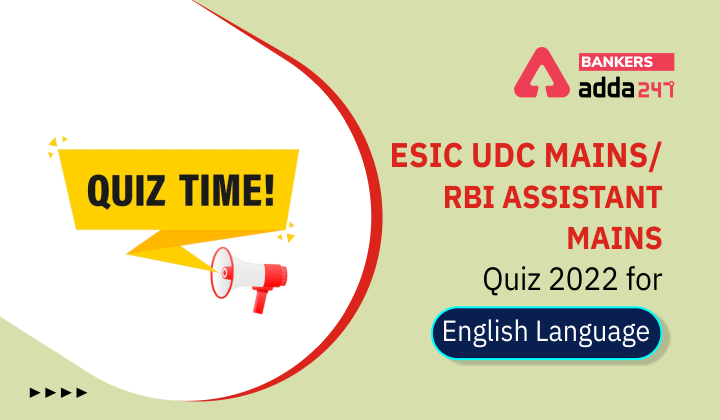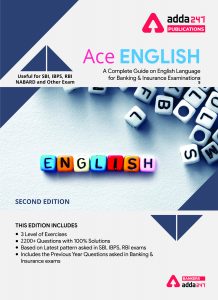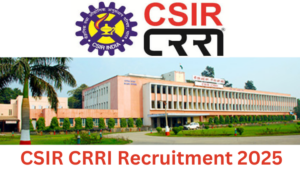Directions (1-10): Each of the following questions has a paragraph from which one phrase/ sentence has been deleted. From the given options, choose the one that completes the paragraph in the most appropriate way.
Q1. A massive Antarctic ice shelf that covered an area about the size of New York City or Rome just collapsed into the ocean. Satellite photos reveal the sudden disappearance of the Conger Ice Shelf on East Antarctica between March 14 and March 16. “The Glenzer Conger Ice Shelf presumably had been there for thousands of years and it’s not ever going to be there again,” University of Minnesota glaciologist Peter Neff told NPR. While the Ice shelf had been slowly shrinking since the 1970s,
____________________________________________.
(a) East Antarctica is one of the coldest and driest locations on planet Earth.
(b) which is a jet of warm, moist air that trapped heat over the region.
(c) as they insulate those glaciers from the warm seawater.
(d) recently accelerated melting preceded this month’s sudden and unexpected collapse.
(e) ice shelf calving events are part of the natural life cycle of an ice shelf.
Q2. The James Webb Space Telescope, the largest and most powerful space telescope ever developed, launched in December. It will travel nearly 1 million miles over 30 days to a stable spot in space, and then take another six months to unfold its instruments, align, and calibrate. The work to create the telescope started in 1996 by NASA, the Canadian Space Agency and the European Space Agency, and it cost around USD 500 million. The launch was delayed several times. For the next several decades, _______________________________________________.
(a) it will track Earth’s orbit around the sun.
(b) first layer of the sun shield can handle maximum temperatures of 383K = approx 231F.
(c) was launched from Europe’s Spaceport in French Guiana on board the powerful Ariane-5 rocket on Christmas day last year.
(d) more than four times as distant as the moon.
(e) the first images from Webb can be expected to start coming in around five months.
Q3. Scientists had a rudimentary understanding of the periodic table of the elements centuries ago. But in the late 19th century, Russian chemist Dmitri Mendeleev published his first attempt at grouping chemical elements according to their atomic weights. There were only about 60 elements known at the time, but Mendeleev realized that when the elements were organized by weight, _____________________________________________.
(a) a sodium atom typically has electrons in the first three energy levels.
(b) 150 years later, chemists officially recognize 118 elements.
(c) because they have the same number of electrons in their outermost shell — the face they show to the world
(d) table starts with the simplest atom, hydrogen, and then organizes the rest of the elements by atomic number.
(e) certain types of elements occurred in regular intervals, or periods.
Q4. Countries that invest in infrastructure, such as the Netherlands, may be able to avoid some effects of flooding. But some investments, such as those being proposed in Florida, cannot be applied everywhere. For example, the restoration of mangroves, as suggested by The Nature Conservancy, and the expansion of coral reefs, are viable only in certain climatic regions. ___________________________________________________________________________.
(a) Should sea levels rise to this extent, it could wreak havoc around the globe.
(b) This small island in the heart of the Pacific, with a population of close to 120,000, could lose two-thirds of its land if sea levels rise by 3 feet.
(c) Moreover, such measures are expensive.
(d) Around 3 million Pacific islanders live within 6.2 miles (10 km) of the coast and, therefore, might need to relocate before the end of the century.
(e) it seems unlikely that any country will disappear entirely by 2100 — though it could be just a matter of time before some are consumed by the ocean.
Q5. The Arctic and Antarctica, while similar habitats in some ways, are home to very different creatures. Both poles host a variety of seal and whale species, but only the Arctic is home to Earth’s largest bear, the polar bear. Polar bears (Ursus maritimus) and their tumbly cubs can be found around the Arctic Circle in Alaska, Canada, Greenland (part of Denmark), Norway, Russia and, occasionally, Iceland. A polar bear’s fur is especially suited for temperatures that can dip below minus 22 degrees Fahrenheit (minus 30 degrees Celsius). They live on ice for most of their lives, feeding on fat-rich seals that keep them energized for long periods between meals. Antarctica also has sea ice, cold temperatures and seals. ____________________________________________________________________.
(a) The big, white bears live on sea ice for almost their entire lives, only occasionally coming ashore to breed.
(b) In the Arctic, polar bears feed on seals and the occasional bird or egg.
(c) To get to Antarctica, polar bears would have to cross the treacherous Drake Passage.
(d) So why aren’t there any polar bears on the southernmost continent?
(e) It’s probably best for the great white bear to remain in the north.
Q6. Under the current limits, set by NASA in 1989, the effective dose limit for an astronaut’s career is based on a maximum 3% lifetime excess risk of cancer mortality. That risk is evaluated with a sliding scale based on age and sex, ranging from a lower career limit of 180 millisieverts (mSv) of radiation for a 30-year-old woman to an upper career limit of 700 mSv for a 60-year-old man. So why is there a lower career limit for radiation exposure for female astronauts than for male astronauts? According to R. Julian Preston, a special government employee with the U.S. Environmental Protection Agency’s Radiation Protection division, NASA’s lower radiation threshold for female astronauts was based on the following finding: When women and men were exposed to high levels of radiation for similar periods of time, ______________________________________________________________.
(a) women had more than twice the risk that men did of developing lung cancer.
(b) such as an eventual trip to Mars, which would expose astronauts to an estimated 900 mSv.
(c) astronauts are exposed to higher levels of ionizing radiation, which increases their risk of developing cancer over the course of their careers.
(d) exposure-induced death for this group and converted that risk, which allows for a much larger margin of error than previously, to a dose.
(e) balance between what the impact of that slightly higher dose was likely to be versus the equality of career opportunity.
Q7. Born in Samos in around 570 B.C, Pythagoras is commonly said to be the first pure mathematician who proposed that everything is a number. Although he is most famous for his mathematical theorem, Pythagoras also made extraordinary developments in astronomy and geometry. He also developed a theory of music while and founded a philosophical and religious school in Croton, Italy. While playing on his lyre, which was an ancient Greek stringed instrument, Pythagoras discovered that the vibrating strings created a beautiful sound when _____________________________________________________________.
(a) concluded that mathematics and music were interconnected and that knowledge of one area led to an understanding of the other.
(b) the ratios of the lengths of the wires were whole numbers, and that this was also true of other instruments.
(c) it simply floats away and finds a new body to live in.
(d) he discovered that the Evening Star and the Morning Star were the same planet, Venus.
(e) in a right angled triangle the square of the hypotenuse is equal to the sum of the squares of the other two sides.
Q8. On Monday, US President Joe Biden told a meeting of business leaders in Washington that among the so-called Quad group of nations, India was being “somewhat shaky” in its response to Vladimir Putin’s invasion of Ukraine. The US, Japan and Australia – the three other members of this coalition formed to counter China’s influence – have been “extremely strong in terms of dealing with Putin’s aggression”, he said. India, however, has doggedly pursued a non-aligned foreign policy since independence. But will the war in Ukraine now put India’s fabled neutrality under strain? India has abstained from voting in the United Nations – three times in a week – on resolutions condemning Russia. There have been reports of a surge of Indian imports of discounted Russian oil as energy prices spiked in the wake of the war. And it has pointedly stopped short of criticising Russia _____________________________________________________________.
(a) said “times have changed now” and there was “an evolution of thinking in India”.
(b) doesn’t benefit the US, which wants India to play counterweight to China in the Indo-Pacific.
(c) which it has called a “longstanding and time-tested friend in the past.”
(d) global order has been built on the UN Charter, international law and respect for sovereignty and territorial integrity of states.
(e) managed to get more than 22,000 Indians out of Ukraine in 90 evacuation flights.
Q9. The UK has committed to reduce its greenhouse-gas emissions to net zero by 2050. Net zero is the point at which the country is taking as much of these climate-changing gases out of the atmosphere as it is putting in. As part of this promise, the government has a target to cut emissions by 78% by 2035, compared with 1990 levels. The Committee on Climate Change (CCC) – a group of experts that advises the government – says the net zero strategy is “ambitious and comprehensive” but _________________________________________.
(a) the government says no new petrol and diesel cars will be sold from 2030.
(b) that the UK government needs to “strengthen delivery” and agree tougher policies.
(c) a small number of £2,500 grants are available for fully electric cars costing less than £35,000.
(d) the environmental impact of people’s diets or a clear strategy for agriculture and land use across the UK.
(e) and the government wants to have a capacity of 5GW of hydrogen production by 2030.
Q10. Globalisation, which has both fans and detractors alike, is being tested like never before after the one-two punch of Covid and war.
The pandemic had already raised questions about the world’s reliance on an economic model that has broken trade barriers, but made countries heavily reliant on each other as production was delocalised over the decades. Companies have been struggling to cope with major bottlenecks in the global supply chain. Russia’s war in Ukraine has raised fears about further disruptions, ____________________________________________________.
(a) especially with China refusing to condemn Russia’s invasion of Ukraine.
(b) Europe off its reliance on Russian fossil fuels is the most recent example of friend-shoring.
(c) with everything from energy supplies to auto parts to exports of wheat and raw materials under threat.
(d) already seen connectivity between nations, companies and even people strained by two years of the pandemic
(e) global trade tensions have prompted the European Union, for instance, to seek “strategic autonomy” in critical sectors.
Solutions
S1. Ans (d)
Sol. Out of all the given options, only option (d) fits into blank in a grammatically correct and contextually meaningful manner.
S2. Ans (a)
Sol. Out of all the given options, only option (a) fits into blank in a grammatically correct and contextually meaningful manner.
S3. Ans (e)
Sol. Out of all the given options, only option (e) fits into blank in a grammatically correct and contextually meaningful manner.
S4. Ans (c)
Sol. Out of all the given options, only option (c) fits into blank in a grammatically correct and contextually meaningful manner.
S5. Ans (d)
Sol. Out of all the given options, only option (d) fits into blank in a grammatically correct and contextually meaningful manner.
S6. Ans (a)
Sol. Out of all the given options, only option (a) fits into blank in a grammatically correct and contextually meaningful manner.
S7. Ans (b)
Sol. Out of all the given options, only option (b) fits into blank in a grammatically correct and contextually meaningful manner.
S8. Ans (c)
Sol. Out of all the given options, only option (c) fits into blank in a grammatically correct and contextually meaningful manner.
S9. Ans (b)
Sol. Out of all the given options, only option (b) fits into blank in a grammatically correct and contextually meaningful manner.
S10. Ans (c)
Sol. Out of all the given options, only option (c) fits into blank in a grammatically correct and contextually meaningful manner.





 GA Capsule for SBI Clerk Mains 2025, Dow...
GA Capsule for SBI Clerk Mains 2025, Dow...
 The Hindu Review October 2022: Download ...
The Hindu Review October 2022: Download ...
 Delhi CSIR CRRI Recruitment 2025 Notific...
Delhi CSIR CRRI Recruitment 2025 Notific...







